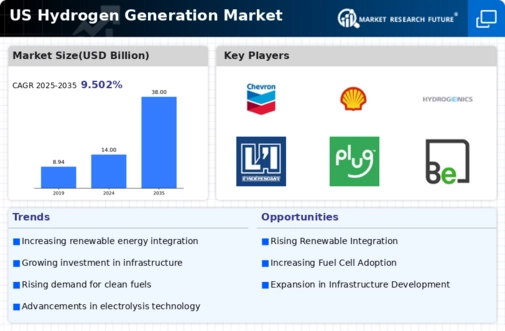Rising Demand for Clean Energy
The hydrogen generation market is experiencing a notable surge in demand driven by the increasing emphasis on clean energy solutions. As the U.S. government sets ambitious targets for reducing greenhouse gas emissions, the hydrogen generation market is positioned to play a pivotal role in achieving these goals. The Biden administration's commitment to a 50-52% reduction in emissions by 2030 is likely to bolster investments in hydrogen technologies. Furthermore, the market is projected to reach approximately $11 billion by 2030, reflecting a compound annual growth rate (CAGR) of around 14% from 2025. This growing demand for clean energy alternatives is expected to stimulate innovation and expansion within the hydrogen generation market, making it a critical component of the U.S. energy landscape.
Industrial Decarbonization Efforts
The hydrogen generation market is significantly influenced by the ongoing industrial decarbonization efforts across various sectors. Industries such as steel, cement, and chemicals are increasingly seeking sustainable alternatives to fossil fuels. Hydrogen, as a clean energy carrier, offers a viable solution for these industries to reduce their carbon footprints. For instance, the steel industry, which accounts for approximately 7% of global CO2 emissions, is exploring hydrogen-based direct reduction processes. The U.S. Department of Energy has initiated programs to support research and development in this area, indicating a strong commitment to fostering the hydrogen generation market. As industries adopt hydrogen solutions, the market is expected to witness substantial growth, potentially reaching $15 billion by 2035.
Investment in Infrastructure Development
The hydrogen generation market is poised for growth due to increased investment in infrastructure development. The establishment of hydrogen production facilities, storage systems, and distribution networks is essential for the market's expansion. The U.S. government has allocated significant funding to support the development of hydrogen infrastructure, with initiatives such as the Hydrogen Energy Earthshot aiming to reduce the cost of clean hydrogen production. This initiative could lead to a reduction in production costs by 80% by 2030. Additionally, private sector investments are also on the rise, with companies committing billions of dollars to develop hydrogen infrastructure. This influx of capital is likely to enhance the hydrogen generation market's capacity and accessibility, facilitating broader adoption of hydrogen technologies across various sectors.
Growing Interest in Fuel Cell Technologies
The hydrogen generation market is benefiting from the growing interest in fuel cell technologies, which are increasingly recognized for their potential in various applications. Fuel cells, which convert hydrogen into electricity, are being adopted in transportation, stationary power generation, and backup power systems. The U.S. Department of Energy has set a target to reduce the cost of fuel cell systems to $30/kW by 2030, which could significantly enhance the competitiveness of hydrogen as an energy source. Moreover, the transportation sector is witnessing a shift towards hydrogen fuel cell vehicles, with major automotive manufacturers investing heavily in this technology. This trend is likely to drive demand for hydrogen generation, as a robust supply chain is essential to support the growing fuel cell market.
Regulatory Framework and Policy Incentives
The hydrogen generation market is significantly shaped by the evolving regulatory framework and policy incentives aimed at promoting sustainable energy. The U.S. government has introduced various policies to encourage the adoption of hydrogen technologies, including tax credits and grants for hydrogen production projects. The Infrastructure Investment and Jobs Act has allocated substantial funding for clean hydrogen initiatives, which is expected to stimulate growth in the hydrogen generation market. Additionally, state-level policies are also emerging, with several states implementing renewable portfolio standards that include hydrogen as a qualifying resource. These regulatory measures are likely to create a favorable environment for investment and innovation in the hydrogen generation market, ultimately contributing to its expansion.






















Leave a Comment